
Are you afraid of heat pumps? Some people are, and it’s usually related to experiences or stories of uncomfortably cold homes. I won’t deny that there have been some horror stories about people suffering in brutally low indoor temperatures during a once-in-a-decade/century/lifetime winter storm. I’ll talk about some of the reasons for that below, but what I really want to do is to show you that heat pumps can keep you warm, even during an arctic blast. And in my case, they can do that even when undersized.
Let’s look at the example of my house. I installed an undersized inverter-driven mini-split heat pump and have been able to see how well it performs in both a heat wave last June and an arctic blast last month. In the heat wave, our indoor temperature barely strayed from our 74°F thermostat setpoint. (See my heat wave article for details.)
So, how did we do in the recent arctic blast, when the outdoor temperature dropped into single digits Fahrenheit, to a low of about -14°C? The answer is below.
My undersized heat pump
Before I get into how my undersized heat pump performed, however, let’s review the sizing. I did the HVAC design myself, beginning with the heating and cooling load calculation. Then I selected the heating and cooling equipment.
I went with Mitsubishi (disclosure: they’re a sponsor of my Energy Vanguard blog) because I wanted inverter-driven minisplit technology. By choosing their Hyper-Heat model, I had confidence that the heat pump would keep pumping out heat even when the temperature drops into the single digits Fahrenheit.

The table above shows the heating and cooling loads (first row) and the capacity of the heat pump (second row). (For the SI folks, see this conversion table for BTU/hr to kW.) As you can see, this heat pump serves ~2300 square feet of floor area. Our heating load is 31,452 BTU per hour (9 kW). The heat pump, according to Mitsubishi’s data, can provide only 20,509 BTU per hour of heat (6 kW). The equipment I selected includes one outdoor unit, the Mitsubishi MXZ-3C24NAHZ2 with Hyper-Heat, and two horizontal ducted indoor units.
Why did I undersize it?
Yeah, that’s really how the numbers turned out. According to the table, our heat pump can provide only 65% of the heat we need. That’s seriously undersized, especially for a system with no auxiliary heat.
Why did I do it? Well, I chose this size equipment for three reasons.
- First, those loads aren’t the final answer. I’ve got more improvements to make on the house, and that’s going to reduce the loads. In short, I’m sizing more for future loads than the as-is house.
- Second, I know that Manual J heating and cooling loads are inflated. I tell people they’re generally 10 to 20 percent higher than the actual loads. The Manual J heating load, for example, doesn’t include the heat provided by lights, appliances, and people.
- And third, I didn’t fully trust the capacities I got from Mitsubishi’s software. I think the heating capacity is probably pretty close, but the latent capacity on the cooling side was suspiciously low.
One more point here: The heating load is based on the winter outdoor design temperature. For Atlanta, Georgia, that’s 23 °F (-5 °C). The idea is that you size the equipment for the design temperature, and the system will run continuously to keep the house comfortable at that outdoor temperature. When the outdoor temperature drops below the design temperature, the house may not be able to maintain the indoor temperature you designed for, which is typically 70 °F (21 °C). But we have a Mitsubishi Hyper-Heat model, which is kind of the equivalent of Nigel Tufnel’s amplifier that goes to 11.
Temperatures during the arctic blast
OK, let’s see the data. First up is a graph showing the indoor temperature in our den along with the outdoor temperature. As mentioned, the outdoors got down to the single digits Fahrenheit. That seems to be a once-a-decade thing here in the Atlanta area. This is my third decade here and the third time I recall that the outdoor temperature dropped this low.
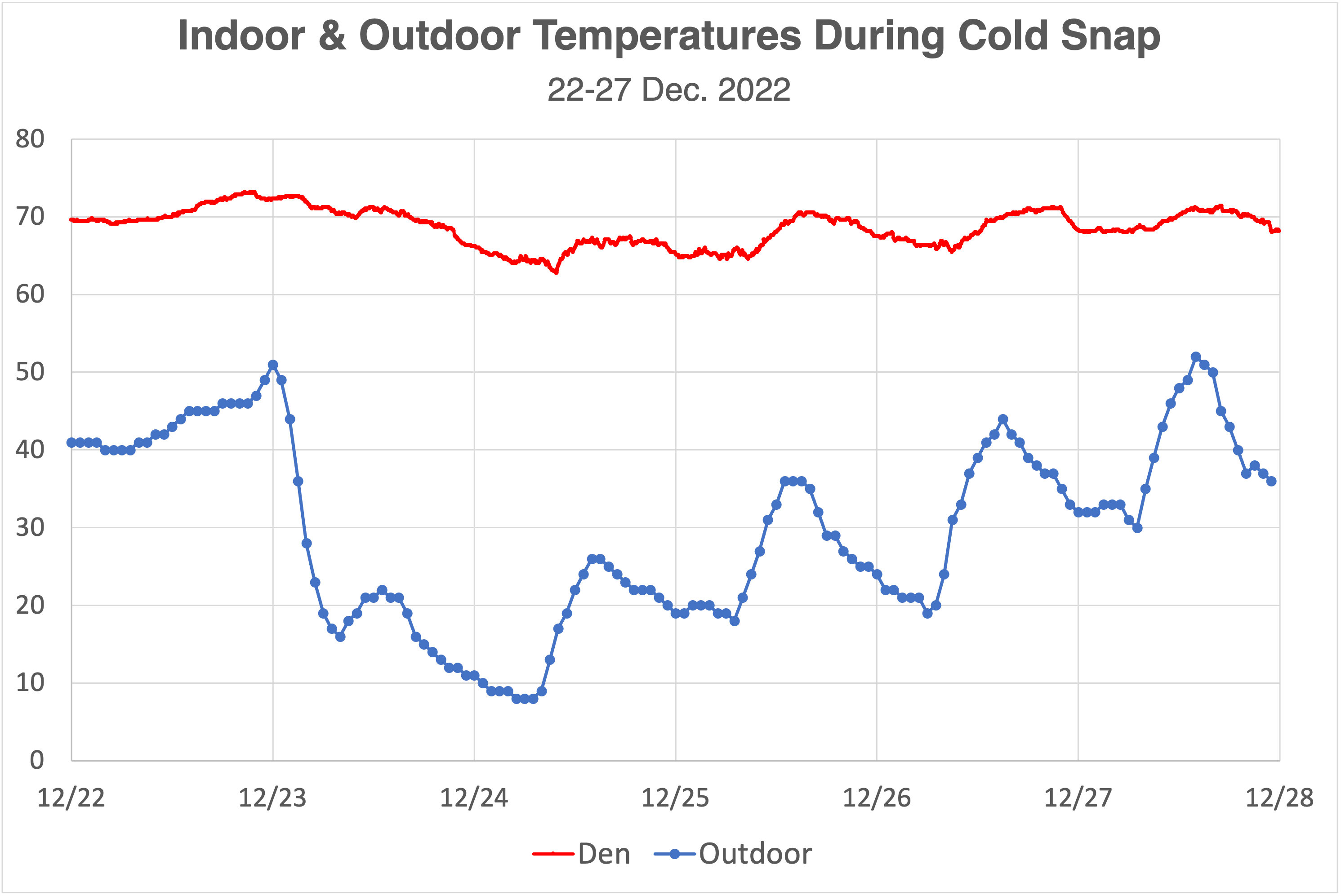
The red curve in the graph shows the indoor temperature in the den. The thermostat for the common areas is in this room, and it’s where we hang out a lot in the mornings and evenings. As you can see, the den temperature did drop in that arctic blast, but the low was 63°F (17°C).
But I need to confess something. The den is the most protected room in the house. It’s connected to the sunroom, but it has no windows and no exterior wall area itself. (It also has a gas log fireplace, but I had the gas turned off in 2019.) Could it be that the den was fine while the rest of the house was freezing?
No! The graph below shows the temperatures in the den (red), primary bedroom (orange), and living room (purple). The living room actually was warmer than the den sometimes, probably because of the solar gain from the south-facing windows. The bedroom was the coolest room. It’s on the northwest corner of the house and also it’s on a separate thermostat, which we keep about 4 or 5 °F (~2.5 °C) lower than the common areas.
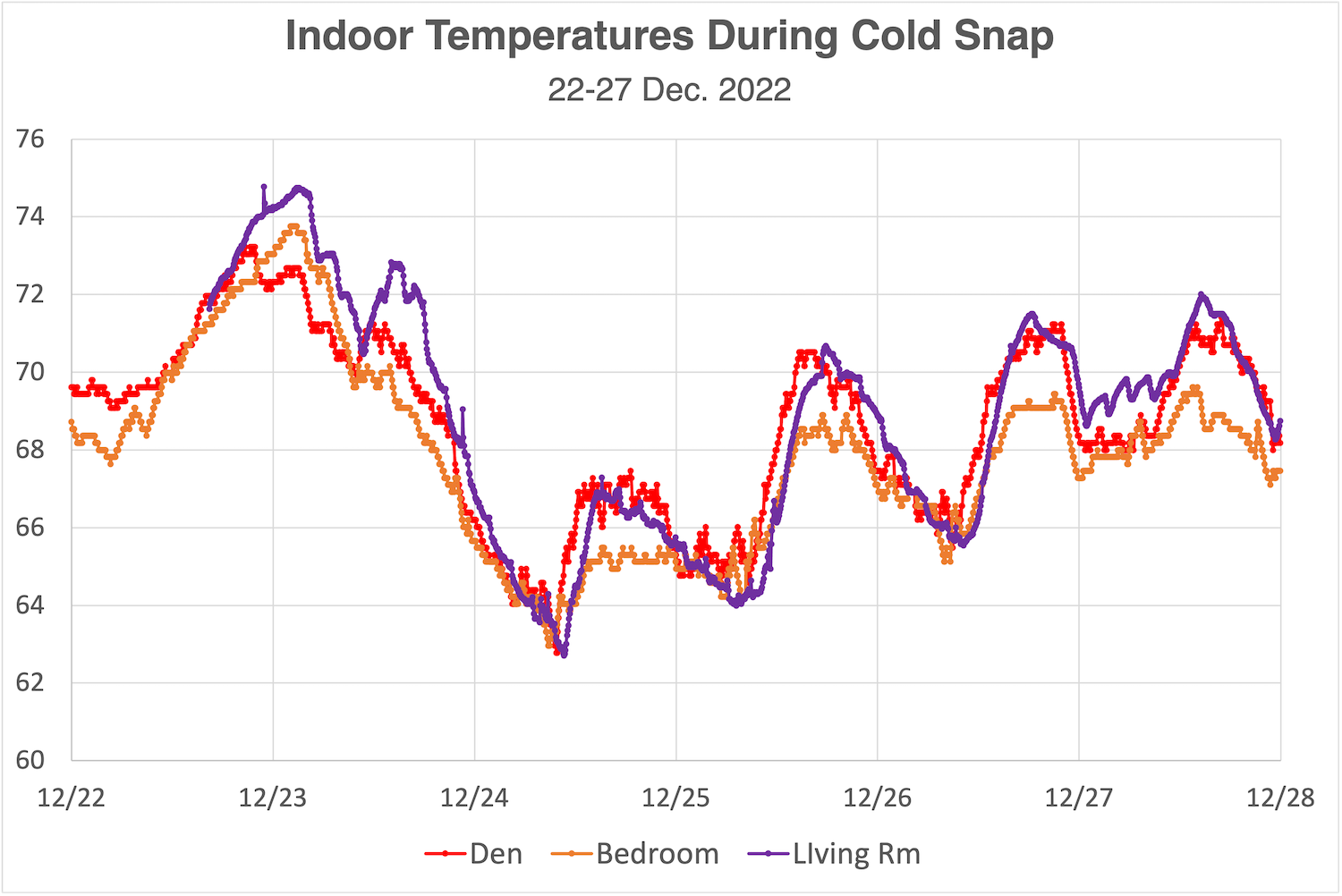
The graph shows that all three rooms hit their minimum of 63°F (17°C) at about the same time. That was a few hours after our outdoor low of ~8°F (-14°C). And then those rooms warmed up quickly. On the coldest day, 24 December, the den and living room got up to 67°F (20°C). By the next day, Christmas, we were back up to 70°F (21°C).
Yeah, 67°F (20°C) is cooler than I usually like it, but I never found it to be too cold. I had a couple of space heaters standing by and didn’t use them. OK, I did use one a couple of times while I was taking a shower. They make nice steam. (Just kidding! I shouldn’t have to say this, but don’t ever put a space heater in the shower.)
Energy use of the heat pump
Since we’re talking about how well the heat pump performed in the blast of frigid air, you may be interested in the energy use, too. The first graph here shows the hourly energy use data (green) and the outdoor temperature (blue) for those same six days.
Even without the temperature data, you can tell when the cold snap started and when it broke by looking at the low points of the energy use curve. The cold weather arrived at about 3 am on 23 December. That’s when the heat pump cranked up to high gear and stayed there until the end of 26 December.
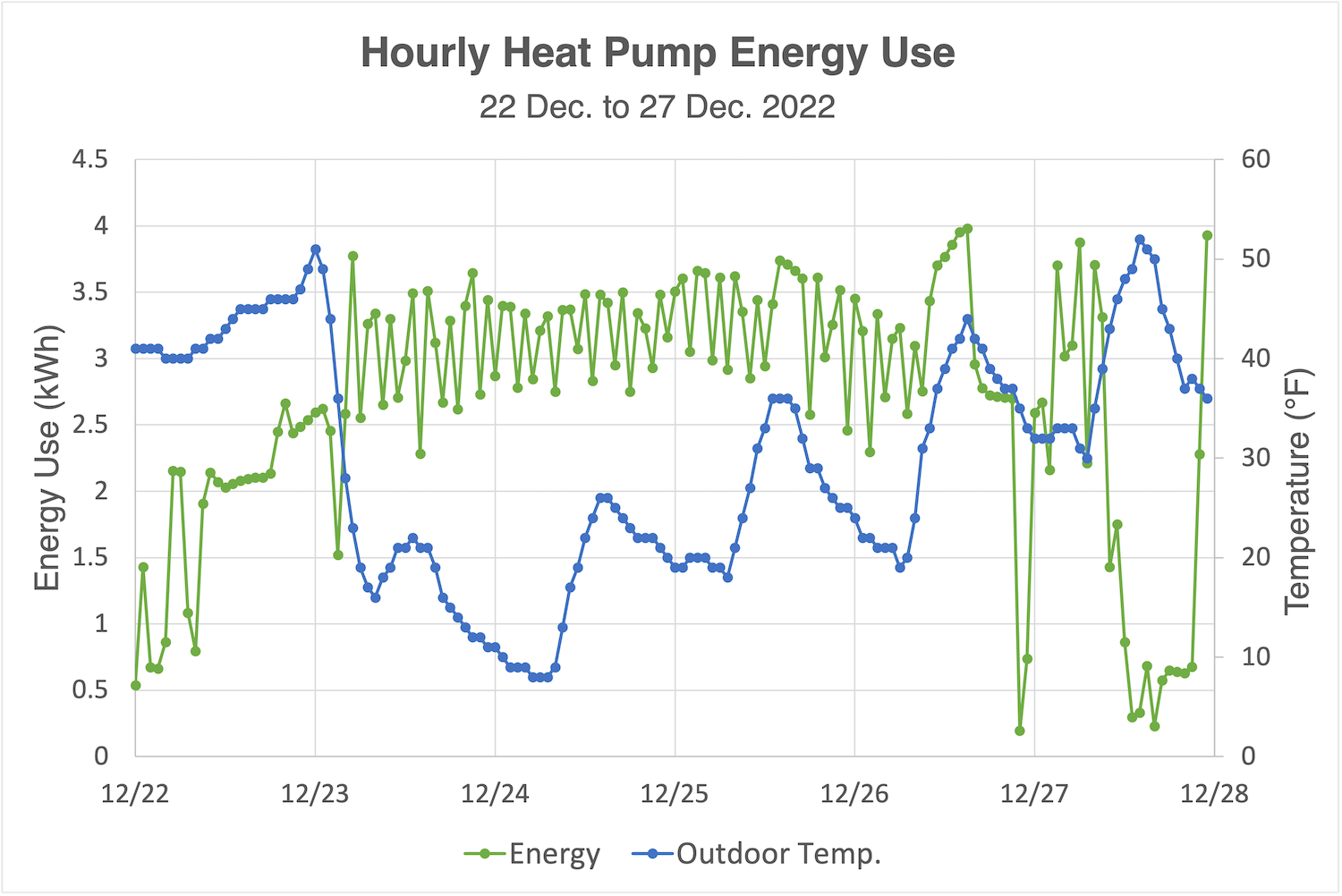
The graph below shows the daily energy use data, but over a longer period of time. I’ve highlighted the six days shown in the above graphs with the blue rectangle below. We hit a high of 80 kilowatt-hours on Christmas day. On our normal cold days, when the outdoor temperature drops into the 20s Fahrenheit (-1 to -6°C), the heat pump uses ~55 kWh.
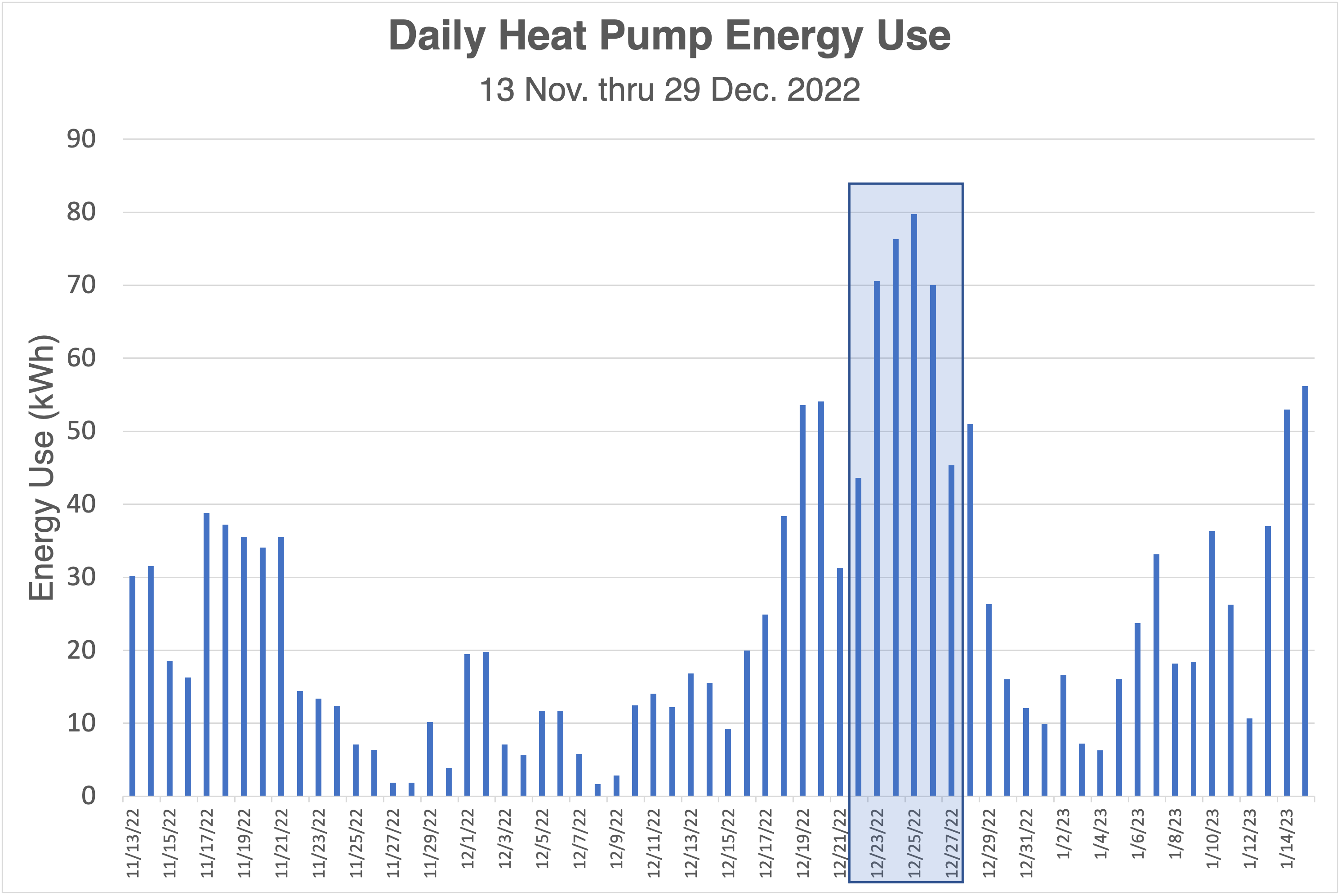
During the coldest part of our cold snap, the heat pump ran flat out almost continuously. The only exceptions were times when (I think) it went into defrost mode. So, 80 kWh per day is probably about as much as this unit will ever use when it’s operating properly.
Why don’t heat pumps always work?
Yes, some people have had bad experiences with heat pumps. I saw a social media post during the arctic blast from someone in the Midwest who said he had heat pumps, and the indoor temperature was in 40s Fahrenheit. Yikes!
A lot of things can cause a heat pump not to be able to keep a house warm enough in really cold weather. Of course, something could be wrong with the unit. But let’s assume the system itself is working as it should. Here are the main reasons a heat pump might not keep you warm.
- The heat pump doesn’t have a way to keep capacity up as the temperature drops. A standard heat pump loses a lot of heating capacity as the outdoor temperature drops. If this kind of heat pump wasn’t sized for its capacity at the design conditions, it may struggle.
- The house is poorly insulated and has a lot of air leakage. Even if sized correctly, a heat pump in such a house may lead to comfort problems because—this may shock some of you—air temperature is NOT the only factor that determines comfort. Mean radiant temperature of the surfaces matters a lot. (See my article on that topic.)
- The heat pump itself is fine, but the duct system is a mess. Ducts in unconditioned spaces—attic, crawl space, garage—can rob your system of a lot of heat. Best is to put the ducts in conditioned space and make sure they’re designed to move air efficiently.
A wrong answer here is that heat pumps just don’t work in cold weather or cold climates. Gary Nelson heats his house in Minneapolis with a heat pump and has done fine at temperatures well below zero Fahrenheit.
Not all heat pumps are created equal. Mitsubishi’s Hyper-Heat models are able to crank out the same amount of heat at about zero Fahrenheit as they do at 47°F, and other manufacturers have similar models. But many models can’t keep up as the outdoor temperature drops. That’s why most heat pump systems have some kind of auxiliary heat.
The sum and substance here is that a house is a system. A heat pump has to be designed to work with the house. The house needs to work with the heat pump. Don’t run out and install an undersized heat pump just because it’s worked for me. Do your homework. Spend the extra money to get good equipment and solid professional help, both for contracting and design.
Next year, I hope to be able to report that we had some really cold weather and our indoor temperature hardly dropped at all. Because this is the year I’m going to redo my basement. It should be fully insulated and much more airtight by next winter. And have its own heating system.
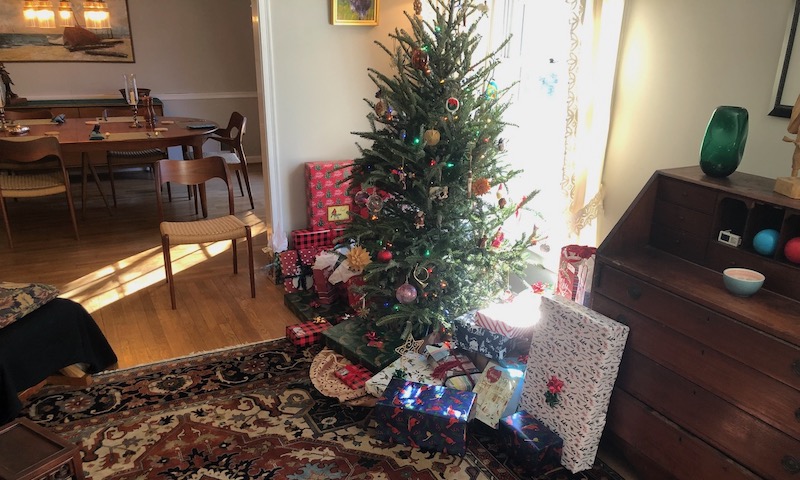
Meanwhile, we had a very nice Christmas this year at my house. I hope you had a nice holiday season, too, however you celebrate it. Now, can you spot the living room data logger in the photo above?
________________________________________________________________________
Allison A. Bailes III, PhD is a speaker, writer, building science consultant, and the founder of Energy Vanguard in Decatur, Georgia. He has a doctorate in physics and writes the Energy Vanguard Blog. He also has written a book on building science. You can follow him on Twitter at @EnergyVanguard. Images courtesy of author.
Weekly Newsletter
Get building science and energy efficiency advice, plus special offers, in your inbox.















28 Comments
Allison, I truly appreciate your data driven discussions on various topics. I suspect this one will be a popular one :-) Posting your energy data along with outside/inside temps leaves little for speculation. I'm sure you'll be quite happy once your basement is buttoned up. We did similar (full retrofit with closed cell SP on the walls) and noticed a big improvement.
I also appreciate your comments on radiated surface temp and comfort. This is very noticeable in our older home where thermal bridging at - 30 C is very noticeable at the floor/wall interface and a challenge for comfort! This radiated thermal performance is very noticeable the minute I walk into a building with thermal breaks built into the envelope at these very cold temps.
Our design temp here is -30 C (zone 7A). I did a calculation based on actual gas use in our home (we use gas for heat, and on-demand hot water) and came up with a 25K/BTU/hour heat load for the Jan-Feb period. This was surprisingly low for a 100 year old house in 7A (about 2400 sq/ft floor area) but I have done extensive retrofits. When looking at the gas company's "compare my use" stats, our home does indeed use about half the volume of gas when compared to homes around us of similar size.
Your article gives me hope that a heat pump/air handler solution might actually be feasible as a replacement for our ducted furnace. What are your thoughts for those of us in the cold north?
Data logger...small white box on your credenza?
Given your circumstances, a 25K/BTU/hour average for the Jan-Feb period seems like a decent average for a two month period.
However when trying to assess the heat load, I would look for one of the coldest 48 hours period of the winter(by watching the weather forecast), do a gas meter reading at the beginning of that 48 hour period and one at the end of of it. My hunch is that during the coldest days of winter, your heat load is over 40k BTU/hour.
According to the Mitsubishi spec sheet, the most performant 48k BTU heat pump will still generate 42k BTU at -4F outdoor temp, but it looks like it won't work at -13F. Not sure what the cut off point is, but I assume that in climate zone 7, -13F or colder is not that uncommon. Efficiency is also greatly reduced when approaching 0F (COP of 2 at 5F). See link below.
Moreover, installation of a large system by a competent installer may come with a sticker shock. I have gone through that calculation and even in my milder climate (Boston) I found that I am better off holding on to my old but highly reliable gas boiler and spending my time and money on better insulation, air sealing and trying to nudge my household members to wear an extra layer of clothing. Although that last one never seem to go anywhere.
https://documents.alpinehomeair.com/product/specforbmhh4822c20220322xlsx.pdf
Vivian, I used this method : https://www.greenbuildingadvisor.com/article/replacing-a-furnace-or-boiler
That method looks good to me in that you are establishing a baseline number for BTU per HDD (over the coldest month) and then applying that to your 99% design temp. We also have an on demand gas hot water heater so if I could remove that from the equation, the heat load would be less yet.
Dennis: Great job improving your old house!
Yes, that's the datalogger.
To my eye it looks like the current balance point for your house is 35° For 72° indoor.
Do you think the 72° set point is higher than you might pick if the HP could maintain say a 69° set point?
Walta
Walta: Looking at the indoor & outdoor temperature graph, I see how you're estimating a 35 °F balance point. And I think that makes sense.
Regarding the 72 °F setpoint, no, I set it there because that's where I'm most comfortable.
That's some useful info. Another factor is that the house has a certain amount of thermal mass -not sure how much in your case. According to the graphs, the below 20F outdoor temperature lasted less than 24 hours. Things would be different in an area that average 10F or less for several consecutive days.
I would also be interested in getting a general idea of the layout of the house and number of heat distribution points and whether you are are satisfied with that configuration.
Vivian,
You are right about the thermal mass impact. I determined my own home to have a thermal mass storage of about 20k Btu per degree F. I did a deep nightly setback at 10 pm and had a known hourly heating load of 360 Btu per degree F Delta. By tying together the Delta T and the internal temperature fall during the nightly setback I made my 20k per degree F thermal storage assumption.
Building thermal storage is a one and done during a cold snap and must be accounted for if your heating system cannot maintain the setpoint. This is where heating system under sizing really stands out. To get back to the heating setpoint and equilibrium you not only have to offset the building heat loss at the time but also bring the internal thermal storage back to the setpoint temperature.
Doug
Typo: "Atlanta" is misspelled in the first caption.
Fixed. Thanks.
Interesting article. You are the best in the business !
One issue that people with mini splits encounter that may frustrate them is that most of these units work off of a remote and there is little relationship between the temperature you select on the remote and the actual temperature in the room. A few weeks ago I installed a 1 ton Fujitsu low temp single head wall unit (similar to Mitsubishi hyper heat) in my walk out basement. I have two of these units on the main floor and they are probably the most efficient low temp mini splits around-rated to -13F and they put out more than 12,000 BTU at -5F....Over the past two weeks of mild weather (in the 30F range at night) the unit has been doing fine keeping the temp at 68F when I selected 70F on the remote. The temp just dropped to 10F last night and the temp in the room (as measurd by the wall thermostat tied to my oil boiler which is only about 12 feet from the wall unit) dropped to 63F. I then used the remote to increase the temp to 72F but five hours later the wall thermostat shows only 65F. I could crank the machine up to 76-78F (I often do this with the units on the main floor) and bring the room temp up faster, but I am ok with a slow increase. However, to people used to instant heat and precise control from a thermostat, this could create complaints.
I know that a Fujitsu wall thermostat would be better, but unfortunately, the wireless wall thermostats for these units now add hundreds of dollars to an already expensive system so I stick with this.
Nick: Thanks for the kind words!
Yes, controls have been an issue with mini-splits. In my case, I have two ducted air handlers, not ductless units, and wall-mounted thermostats.
Allison, are those Møller chairs? Those are beautiful!
I heard there was a datalogger in the picture, it's probably also cool. :-)
Chris: Yes, they are. Good eye! They and the Danish table behind are from the early '60s and belonged to my wife's mom and stepdad. We love them!
Our Pretty Good House in Maine was at 69° at 7 AM today (Saturday). Outside temperature was -17°. Wind still howling. Two minisplits (only heat source) were pumping out heat in spite of the cold.
Having a robust building envelope is obviously the key to staying warm in the occasional episode of temperatures well below 99% design.
If you dont mind being asked, what are your: a) square footage and b) blower door numbers? Just trying to imagine exactly how airtight we would need to be to safely heat with mini splits only on a day like today, yesterday, or – – especially – – last night. Thanks
Blower door:
.59 ach50.
House is around 1650 square feet of conditioned space.
Our 99% design temperature is zero° F.
Obviously, whether a house can coast through extreme cold depends on insulation and airtightness, as well as the output of heating appliances. Fortunately, when it's this cold, it's generally clear, so we get a lot of solar gain during the day. It was 75° here yesterday, heat was not running at all, even though it was below zero.
Hi Stephen, could you provide detail on your system? Brand? Models? ducted or ductless? Back-up heat?
These type of testimonials are hugely helpful to those that are on the cusp of cold climate heat pump decisions.
Many thanks in advance!
Jim: We have two Fujitsu cold climate minisplits, nominal 12,000 btu and 15,000 btu. Model designations have changes since 2015 when they were installed. They were RLS3h, I think.
No back up heat. Midcoast Maine, midway between Augusta and the coast.
Thanks so much! I'm planning for Fujitsu cold climate units as well. Glad to hear they're working well!
For those of you who are interested in more information, Stephen blogged his build here on GBA: https://www.greenbuildingadvisor.com/article/pretty-good-not-so-big-maine-house
Stephen, it's impressive that your heat pumps are still producing heat at this temperature, and also testament to the value of a high-performance, Pretty Good envelope! As you know, we're practically neighbors by Maine standards and I've heard of others with poor-to-modest building envelopes and even with oversized mini-splits they aren't keeping up.
Do you know if they are running Mitsubishi or Fujitsu?
It's probably the envelope as you say, but part of me is starting to wonder if the Fujitsu's have some magic that transcends the specs.
Michael- Given the limited output of most minisplits, around 15-17000 btu maximum, unless you've got a lot of them, a big drafty house, like our previous one, would be hard to heat at the cold temperatures we just experienced.
Our daughter lives in Philadelphia in a drafty old stone house, with minimal insulation. I built her a new kitchen that she had a mini split installed in. It does a decent job heating the kitchen/ dining area, but she'd need supplemental heat if it ever gets near zero, so the oil furnace is still available. I think that makes a lot of sense for existing houses that haven't received a total rehab.
My house has a 1980's vintage average envelope. I have 3 one ton Fujitsus, two older 12k Low Temp models (RLS3) and a brand new AOUG12LZAH1...These units are rated at 16kbtu's at around 5F. They were all putting out a lot of heat a -3F or so. However, the bigger issue is delivering the hot air where you need it. A few things I noted: First, as I mentioned above, the temperature I selected on the remote had to be higher than the temperature in the room (74-76F to achieve a 70 F room temp) and high fan speed is needed. Second, it takes longer to raise the temperature in a room with the mini splits than it does with baseboard. Finally, when the temp really dropped my wife still preferred to run the baseboard in the bedrooms and bath because it does feel a little less stratified and the Fujitsus in the main rooms could not get enough hot air down the hallways and into the bedrooms to her liking.
Please allow me to suggest an alternative to heat pumps - FAR Infrared radiant cove and/or ceiling panel heaters.
We recently bought and did a thorough energy makeover on a 60's era, 1600 sq ft, all-electric brick rancher on the northern edge of Zone 4A. The house had a 10 yr old, semi-functional, 11kW solar array.
We did a blower door test, sealed air leaks, insulated the roof to R60+ (no new insulation in walls), installed new "cool roof" shingles, replaced the windows (the old ones were shot), upgraded to a heat pump water heater and rehabbed the solar array using the Enphase Legacy Upgrade plan.
The house had the original baseboard heaters and a new a/c unit with good, well-insulated ducting. Obviously, the baseboards had to be replaced, but with what? Replacing a new a/c unit seemed dumb and, after much reading and discussion w/ HVAC pros, vendors, manufacturers etc, we decided on FAR Infrared units from Comfort Cove and DucoTerra (we have no affiliation w/ either company).
The Infrared heaters were less expensive on the front end and installed easily using the baseboards' circuits, breakers and thermostats (upgraded to digital). They have no moving parts thus require zero maintenance and never need to be replaced. Their efficiency doesn't degrade over time and they perform the same whether the outside temp is 50F or -5F. There's nothing to break, so no worries about a pump failing during the holidays with the house full of guests and all the HVAC techs on vacation. They produce a terrific form of draft-free heat (like sitting in the warm sun on a cold day). are silent, are zoned by room (so no need to heat unused rooms) and don't use climate-damaging coolants. Literature on the infrared units (some of it from the manufacturers, admittedly) indicate that their efficiency falls between central heat pumps and minis. We also weighed the savings from eliminating annual maintenance and having to replace a heat pump every 15 years or so.
During the first full year after all upgrades were completed, we produced 40% more kWh and consumed 50% fewer kWh. We now have a 60 yr old, "good enough" Net Zero home that produces slightly more energy than we consume - all for about the cost of a mid-sized SUV'
chuckwalla,
I'm glad your renovations have produced such good results for you, but unfortunately the efficiency of cove heater is exactly the same as baseboard or any other electric resistance heaters - That is a COP of 1 as compared to somewhere around 2 to 3 for heat pumps. There are anecdotal accounts that with infrared heaters you can keep your house slightly colder and experience the same level of comfort, that that's in the weeds in terms of energy savings.
This is a great article and I really appreciate the data. We have a Victorian home in the Pacific NW, leaky, and little insulation, some new windows, some original, ~2,100 square feet on two floors plus a new 1,000 sf heated basement. Upstairs we have fan coils, with the basement floor, radiant. I used loadcalc.net freeware and some careful input to arrive at 49K BTU/hr heat load before remodeling, and ~34 K BTU/hr after insulating walls and getting all the windows up to snuff. I bought and installed a SpacePak 5 ton inverter air to water heat pump with published performance of 35K BTU/hr at 19F, 50K BTU/hr at 36F, and 53K BTU/hr at 45F, all at 122 F return water temp. Fan coils are rated at 4.,300 BTU/hr at that water temp. My buffer tank has 6 KW aux heaters (~20 K BTU/hr). Near freezing, they come on if all zones are calling for heat. Above freezing they don't. At present when it is near freezing, the fan coils struggle to heat the house to 68 F with their fans cranked up to max. even if the basement is not calling for heat. Basement is not yet fully insulated and I expect everything to be right sized when the whole house is complete. Heat pump appears to be performing as published based on delta T and flow through it. This article gives me hope.
Log in or create an account to post a comment.
Sign up Log in